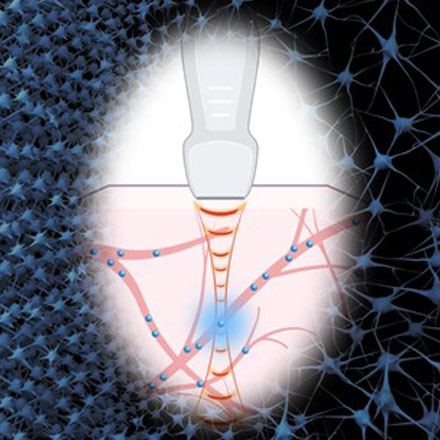Join us for a FREE Webinar
Seeing the Sound: Optical Neural Interfaces for In Vivo Neuromodulation
Wednesday, January 6, 2021 1:00 PM - 2:00 PM EST
|
|
|

|
Optogenetics has transformed experimental neuroscience by manipulating the activity of specific cell types with light, enabling in vivo neuromodulation with millisecond temporal resolution. Visible light with wavelengths of between 430 nm and 640 nm is used for optogenetics, limiting penetration depth in vivo and resulting in an invasive fiber-tethered interface that damages the endogenous neural tissue and constrains an animal’s free behavior.
In this talk, Guosong Hong, Ph.D., of Stanford University will present two recent methods to address this challenge: “sono-optogenetics” and “macromolecular infrared nanotransducers for deep-brain stimulation (MINDS).”
For the first method, he will demonstrate that mechanoluminescent nanoparticles can act as circulation-delivered nanotransducers to convert sound into light for noninvasive optogenetic neuromodulation in live mice. For the second method, he will demonstrate how 1064-nm near-infrared-II light can penetrate the brain to reach 5-mm depths for modulating neural activity in tether-free, freely behaving animals. To conclude, Hong will present an outlook on how photonics may advance neuroscience research by reducing the invasiveness and mechanical restraints in live animals and even humans. The webinar will close with a Q&A.
Who should attend:
Those working or training in biomedical imaging who use, monitor, or commercialize equipment for neuroscience. Anyone interested in learning about new methods for optogenetic research. Microscopy specialists and others in the biomedical fields seeking insights into noninvasive photonics technologies for diagnosis and research.
About the presenter:
Hong received his Ph.D. in chemistry from Stanford University in 2014, and then carried out postdoctoral studies at Harvard University. He joined Stanford Materials Science and Engineering and Neurosciences Institute as an assistant professor in 2018, and his research at Stanford aims to develop and apply novel optical and electronic materials for minimally invasive brain interfacing. He has published more than 70 papers in journals including Science, Nature Reviews Neuroscience, Nature Medicine, Nature Photonics, Nature Methods, Nature Biomedical Engineering, Nature Materials, Nature Nanotechnology, Nature Communications, and PNAS. He is a recipient of the NIH Pathway to Independence (K99/R00) Award, the MIT Technology Review ‘35 Innovators Under 35’ Award, and the Science PINS Prize for Neuromodulation.
|
|
|
|
Date: Wednesday, January 6, 2021
Time: 1:00 PM - 2:00 PM EST
Space is limited. Reserve your Webinar seat now at: https://attendee.gotowebinar.com/register/4211080468046684687
After registering you will receive a confirmation email containing information about joining the Webinar.
|
|
|
SYSTEM REQUIREMENTS
Operating System
Windows® 7 or later, Mac OS® X 10.9 or later, Linux®, Google ChromeTM OS
AndroidTM OS 5 or later, iOS® 10 or later
Web Browser
Google ChromeTM (most recent 2 versions)
Mozilla Firefox® (most recent 2 versions)
Mobile Devices
AndroidTM 5 or later
iPhone® 4S or later
iPad® 2 or later
Windows Phone® 8+, Windows® 8RT+
|
|
|
|
.: More from Photonics Media
|
|
|